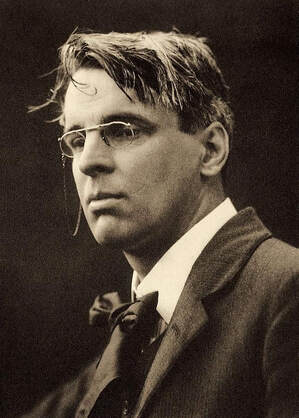Down By the Salley Gardens
| Down by the salley gardens my love and I did meet; She passed the salley gardens with little snow-white feet. She bid me take love easy, as the leaves grow on the tree; But I, being young and foolish, with her would not agree. In a field by the river my love and I did stand, And on my leaning shoulder she laid her snow-white hand. She bid me take life easy, as the grass grows on the weirs; But I was young and foolish, and now am full of tears. W.B. Yeats |
Monsignor Ryan’s Reflections on “Down by the Salley Gardens”
“Down by the Salley Gardens” was one of Yeats’ great early poems. It was first published in “The Wanderings Of Oisin and Other Poems”. Although this is one of Yeats most straightforward poems it is worth exploring some of the language and imagery. What are the “Salley Gardens” and what was W. B. Yeats doing down by them with his beloved?
Although it is not known for sure one theory is that “Salley Gardens” refer to the banks of the River Ballysadare (near Sligo). Willow trees along the river were used to cultivate thatch for the roofs of houses. This may have given rise to the names for the gardens. The Latin for willow tree is “salix” but the Irish Gaelic for willow trees is “saileach” which is nearer and which may have given rise to the word “salley”.
In summary, “Down by the Salley Gardens” sees Yeats’ speaker ruefully reminiscing about his younger days with his sweetheart when they would go and meet by the salley gardens. His beloved would entreat him to “take love easy” and not to be too impetuous or rash when it came to love and relationships.
But he didn’t heed her words because he was young and foolish. Then looking back he is “full of tears” regretting the fact that he didn’t listen to his lover’s advice.
“Down by the Salley Gardens” may be an early poem of W. B. Yeats, but it remains one of his most celebrated lyric poems because of the regret and sorrow running through it. While the locus of the poem seems to be Sligo, for me the poem reminds me of nearby Donegal, of long summer days, sandy beaches and the pleasantest of memories, good craic and good company.
“Down by the Salley Gardens” was one of Yeats’ great early poems. It was first published in “The Wanderings Of Oisin and Other Poems”. Although this is one of Yeats most straightforward poems it is worth exploring some of the language and imagery. What are the “Salley Gardens” and what was W. B. Yeats doing down by them with his beloved?
Although it is not known for sure one theory is that “Salley Gardens” refer to the banks of the River Ballysadare (near Sligo). Willow trees along the river were used to cultivate thatch for the roofs of houses. This may have given rise to the names for the gardens. The Latin for willow tree is “salix” but the Irish Gaelic for willow trees is “saileach” which is nearer and which may have given rise to the word “salley”.
In summary, “Down by the Salley Gardens” sees Yeats’ speaker ruefully reminiscing about his younger days with his sweetheart when they would go and meet by the salley gardens. His beloved would entreat him to “take love easy” and not to be too impetuous or rash when it came to love and relationships.
But he didn’t heed her words because he was young and foolish. Then looking back he is “full of tears” regretting the fact that he didn’t listen to his lover’s advice.
“Down by the Salley Gardens” may be an early poem of W. B. Yeats, but it remains one of his most celebrated lyric poems because of the regret and sorrow running through it. While the locus of the poem seems to be Sligo, for me the poem reminds me of nearby Donegal, of long summer days, sandy beaches and the pleasantest of memories, good craic and good company.
William Butler Yeats 1865 – 1939
W. B. Yeats was an Irish poet and one of the foremost figures of 20th century literature. A pillar of the Irish literary establishment he helped to found the Abbey Theatre and in his latter days he served two terms as a senator in the Irish Free State. His early works include “The Wanderings of Oisin and Other Poems”. He was awarded the Nobel Prize for Literature in 1923.
Although trained as lawyer he abandoned the law for art school. In addition to his poetry, Yeats devoted significant energy to writing plays. He collaborated with Lady Gregory to develop works for the Irish stage e.g. “Cathleen ni Houlihan” then “Deirdre” and “At the Hawk’s Well”.
He became a political figure in the new Irish Free State. The publication of “Last Poems” and “Two Plays” shortly after his death further cemented his legacy as a leading poet and playwright.
W. B. Yeats was an Irish poet and one of the foremost figures of 20th century literature. A pillar of the Irish literary establishment he helped to found the Abbey Theatre and in his latter days he served two terms as a senator in the Irish Free State. His early works include “The Wanderings of Oisin and Other Poems”. He was awarded the Nobel Prize for Literature in 1923.
Although trained as lawyer he abandoned the law for art school. In addition to his poetry, Yeats devoted significant energy to writing plays. He collaborated with Lady Gregory to develop works for the Irish stage e.g. “Cathleen ni Houlihan” then “Deirdre” and “At the Hawk’s Well”.
He became a political figure in the new Irish Free State. The publication of “Last Poems” and “Two Plays” shortly after his death further cemented his legacy as a leading poet and playwright.

 RSS Feed
RSS Feed